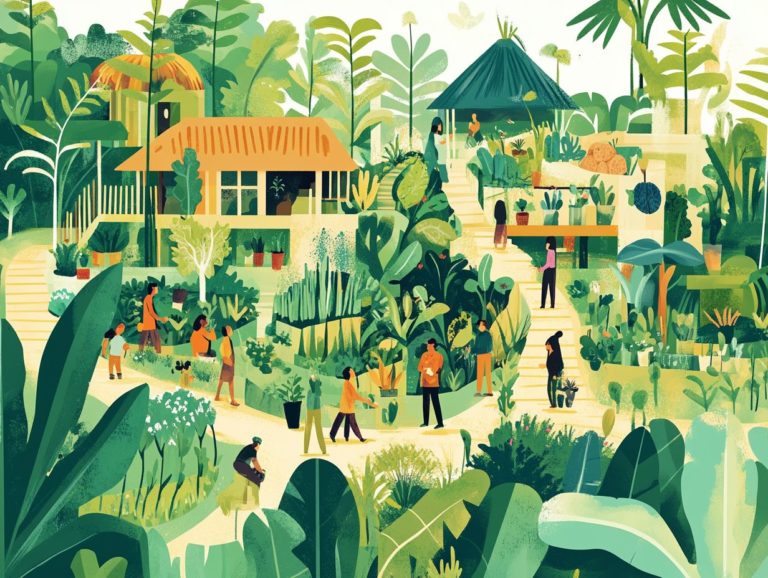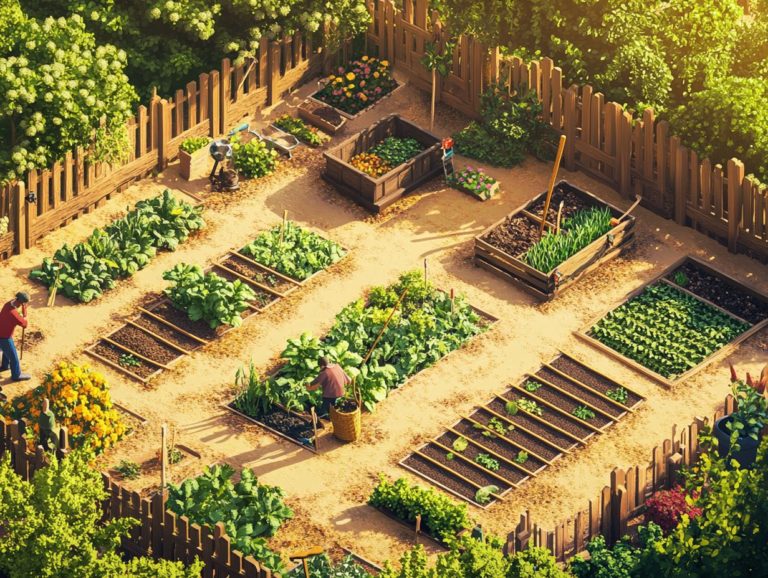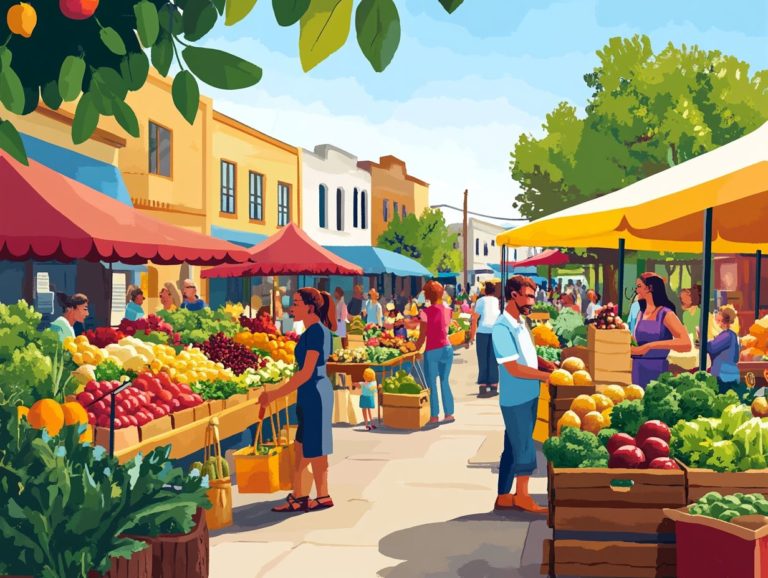61. Building Community Resilience Through Permaculture
In a world grappling with escalating environmental challenges and social uncertainties, the concept of permaculture stands as a beacon of hope for you.
By merging sustainable agricultural practices with community development, permaculture enhances food security, fortifies social bonds, and fosters economic resilience.
This article delves into the core principles of permaculture, highlighting its benefits for communities and offering practical steps for implementation.
Discover how permaculture empowers communities like yours to flourish in the face of adversity.
Contents
- Key Takeaways:
- The Concept of Permaculture
- Benefits of Permaculture for Community Resilience
- Implementing Sustainable Gardening in Communities
- Examples of Successful Sustainable Gardening Projects
- Challenges and Solutions for Sustainable Gardening in Communities
- Building Resilient Communities through Permaculture
- Frequently Asked Questions
Key Takeaways:
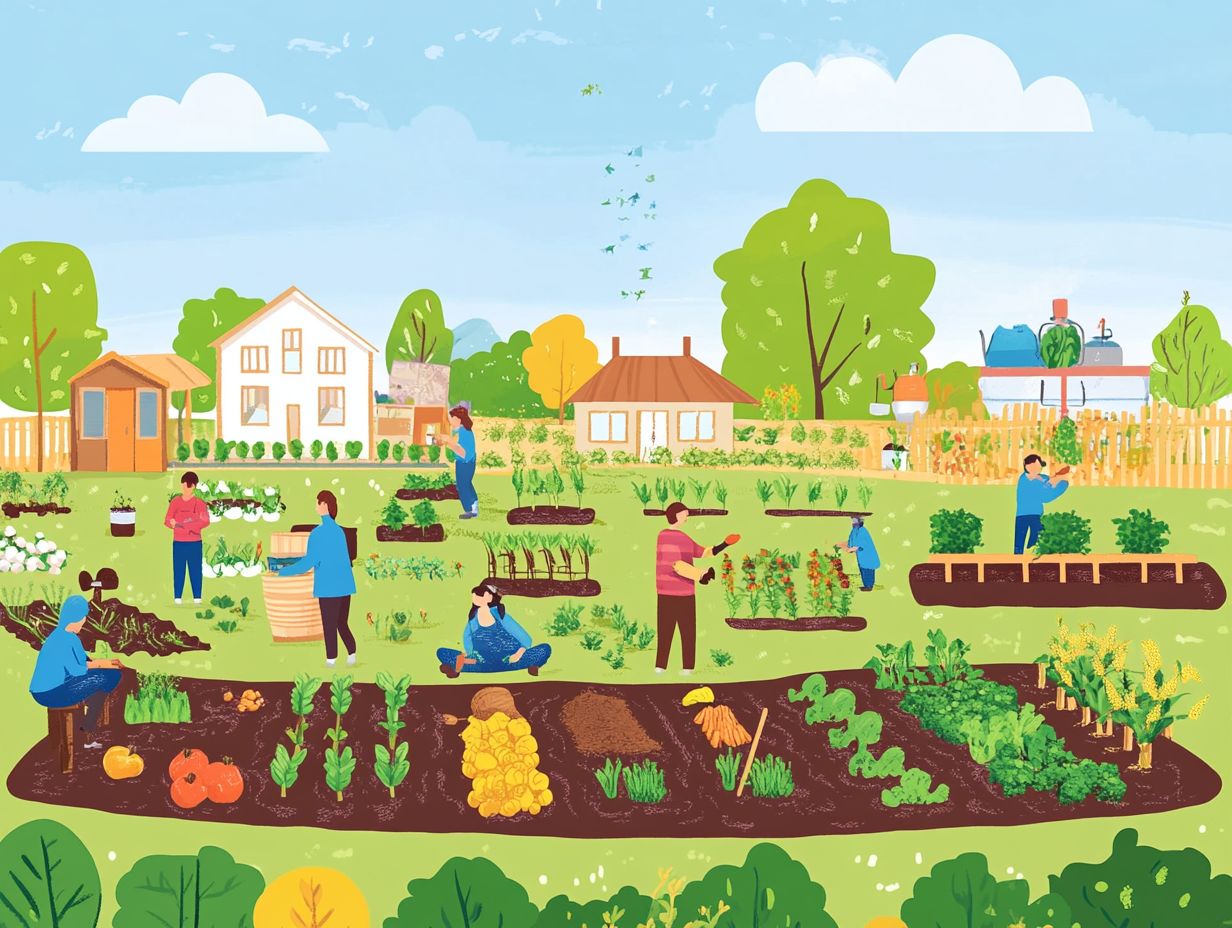
- Permaculture is a way to design that considers the whole system, focusing on working with nature.
- Implementing permaculture practices allows communities to enjoy improved environmental, social, and economic resilience.
- Successful permaculture implementation in communities requires careful planning, community involvement, and collective problem-solving.
The Concept of Permaculture
Permaculture embodies a holistic design approach grounded in the principles of ecological design. It aspires to cultivate sustainable and self-sufficient ecosystems that reflect the beauty and functionality of natural landscapes.
By harnessing the wisdom of indigenous societies, it integrates community planning sessions to foster a participatory culture. This approach enhances community resilience by using local knowledge and ecological principles, especially in urban areas.
Definition and Principles
Permaculture encompasses a sophisticated set of ecological design principles that guide sustainable practices, seamlessly integrating agriculture, architecture, and community enablement.
At its core, it champions a holistic approach to crafting systems that mirror natural ecosystems, promoting resilience and self-sufficiency. Imagine a permaculture garden where companion planting is the name of the game diverse crops grow together in harmony, enhancing soil health and naturally warding off pests.
By incorporating systems that recycle water from sinks and showers into residential designs, you conserve water and provide irrigation for landscape plants. This illustrates how sustainability can elegantly weave into everyday life. As you cultivate design literacy, you learn to observe and engage with your environment effectively, ensuring that both your personal and communal spaces flourish in harmony with nature.
Benefits of Permaculture for Community Resilience
Applying permaculture principles offers substantial advantages in fostering community resilience. It enhances social cohesion, promotes environmental sustainability, and strengthens economic viability, all through grassroots initiatives and the enablement of local democracy, highlighting the power of community in permaculture design.
Environmental, Social, and Economic Benefits
Permaculture presents a wealth of environmental, social, and economic advantages that play a crucial role in community building while addressing urgent public health challenges and social issues.
- By embracing ecological design principles, permaculture boosts biodiversity.
- It promotes sustainable land-use practices that can significantly lower carbon footprints and cultivate healthier ecosystems.
- When established using permaculture techniques, community gardens thrive in urban settings, providing fresh produce and fostering meaningful social connections.
- A compelling case study from Detroit showcases how residents transformed neglected lots into vibrant gardens, cultivating a shared sense of purpose and enhancing food security.
- These practices foster knowledge sharing and collaboration among community members, strengthening social ties and enabling individuals to actively engage with their local environment.
Now is the time to embrace permaculture for a sustainable future! To get started, consider exploring the essential tools for community permaculture projects. Are you ready to help your community thrive?
Implementing Sustainable Gardening in Communities
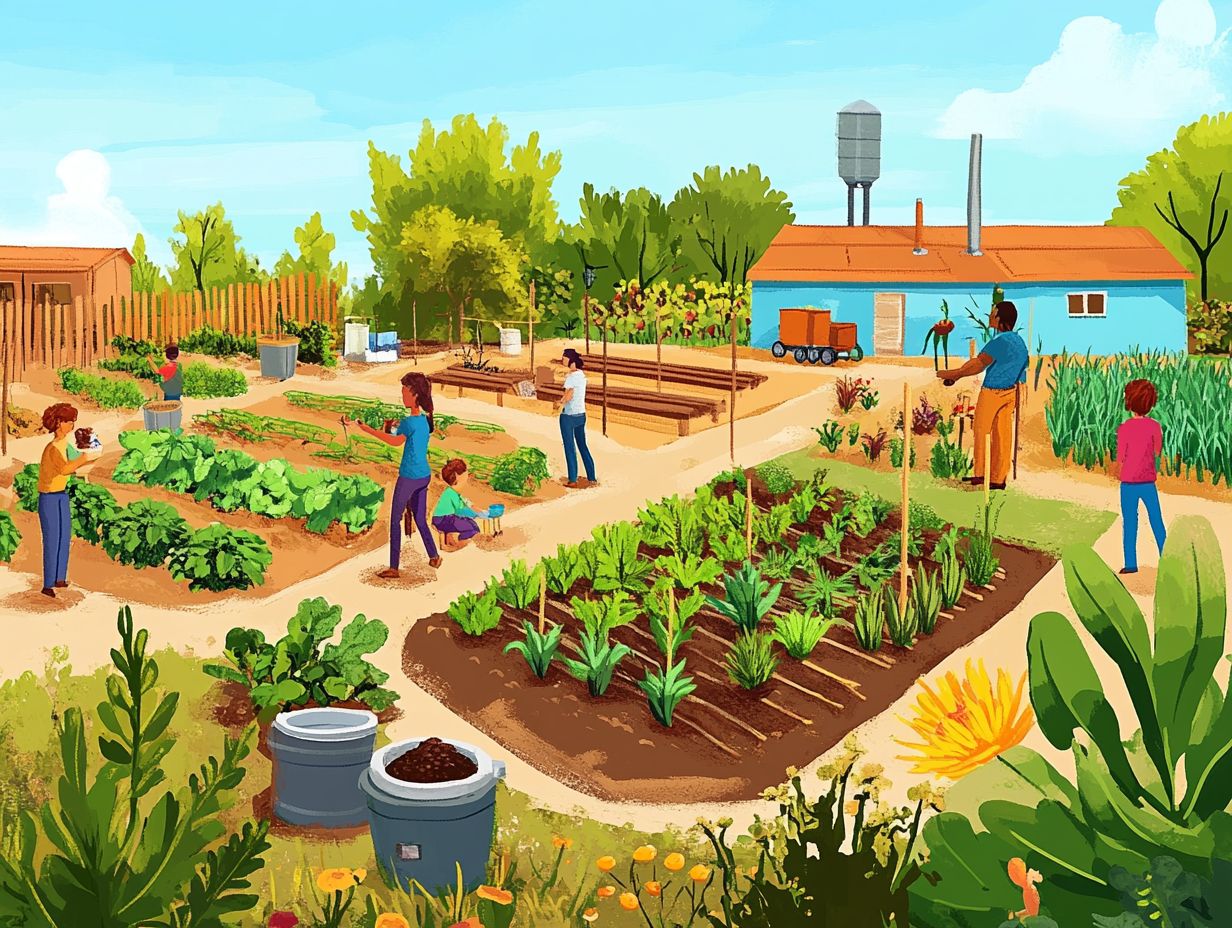
Implementing sustainable gardening in communities requires thoughtful planning and collaboration. Using methods such as community design charrettes and design that involves the community in decision-making ensures local voices are acknowledged and integral to the process. This allows for a richer, more inclusive approach to sustainable development.
Steps and Strategies for Implementation
Implementing sustainable gardening effectively requires you to engage deeply with your community. Tap into grassroots initiatives and harness local knowledge to craft strategies that address specific needs.
To kick off this process, organize workshops and information sessions. Actively involve local residents in discussions about sustainable practices.
By fostering an inclusive atmosphere, you allow communities to share their insights, challenges, and aspirations concerning environmental stewardship.
Building partnerships with local organizations can amplify your outreach and facilitate resource-sharing, enriching the collective knowledge base. Community members can also form smaller action groups focused on unique aspects of sustainable gardening, such as urban gardening or water conservation. This enables targeted efforts that truly resonate with their interests.
This collaborative approach strengthens community bonds and enables individuals to take ownership of their environment. It ensures that sustainable gardening initiatives leave a lasting impact.
Examples of Successful Sustainable Gardening Projects
Successful sustainable gardening projects worldwide stand as compelling case studies, showcasing the transformative potential of community design rooted in ecological principles and a culture of participation.
Engaging with these examples shows how thoughtful design can revitalize ecosystems and foster community resilience.
Case Studies and Lessons Learned
Looking at successful case studies reveals valuable insights into the significance of community networks, innovative natural building techniques, and the establishment of public squares as essential communal spaces.
These projects illustrate how cultivating collaborative relationships among local residents fosters shared resources, enhances resilience, and promotes sustainability. For example, one case study from a rural area showed that integrating pollinator gardens not only increased local biodiversity but also strengthened community bonds as residents engaged in maintenance workshops together.
Challenges often arise when opinions differ during decisions, highlighting the necessity for effective communication strategies. By reflecting on these experiences, future initiatives can emphasize inclusive planning and transparency, ensuring that everyone feels valued and invested in achieving collective goals.
Challenges and Solutions for Sustainable Gardening in Communities
Despite the myriad benefits that sustainable gardening offers, you may encounter various challenges and common obstacles within your community. These hurdles demand innovative solutions to foster meaningful participation and effectively tackle public health issues.
Join us in overcoming these obstacles and making a positive impact in your community!
Common Obstacles and How to Overcome Them
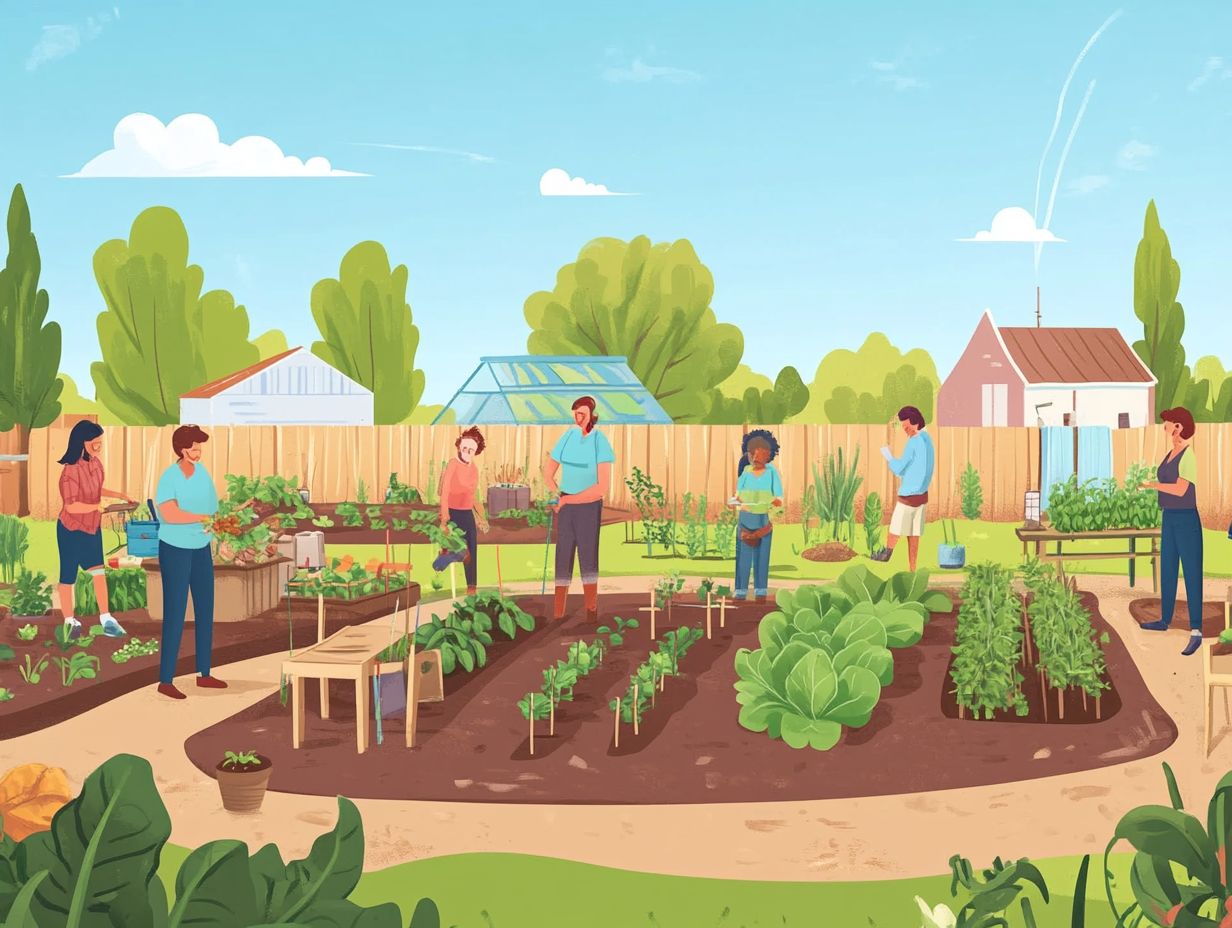
Common obstacles in permaculture implementation often stem from social issues. You can effectively address these challenges through strategies like non-violent communication and strong community outreach.
You might find that communities struggle with conflicting perspectives on land use and resource allocation. This leads to heightened tensions and collaboration difficulties. To navigate these challenges, creating an environment of empathy and openness is essential.
Engaging community members through workshops creates a platform for individuals to express their views freely while learning from one another’s experiences. This fosters a shared understanding of goals.
Integrating local cultural values into permaculture practices is key to building trust and securing buy-in from residents. By nurturing strong relationships and facilitating continuous dialogue, you can empower communities to tackle obstacles head-on and even explore the role of art in permaculture communities to boost their resilience toward sustainable living.
Building Resilient Communities through Permaculture
Building resilient communities through permaculture principles equips you for potential disasters. For insights on enhancing this process, explore how to develop community leadership in permaculture. It also enables residents to recover and flourish amidst adversity.
This approach nurtures a profound sense of interdependence and creates a supportive network that helps everyone thrive.
How Permaculture Can Help Communities Prepare for and Recover from Disasters
Permaculture enhances disaster preparedness in your community by establishing robust networks and employing ecological design principles. For a deeper understanding of this concept, explore the role of community in permaculture design. This bolsters resilience and facilitates recovery.
By fostering collaboration among residents, permaculture cultivates local resources and knowledge, enabling quick responses to emergencies. However, there are also challenges to consider, as outlined in the article on challenges facing permaculture communities today. Techniques such as food forests and rainwater harvesting systems provide essential sustenance during crises while maintaining biodiversity and stabilizing ecosystems.
Integrating these methods encourages community members to share skills and tools. This creates a nurturing culture that can effectively rebound from adverse events. With a focus on sustainable practices, ensure that when disasters strike, recovery processes align with ecological principles, resulting in systems that are not just restored but enhanced for long-term sustainability.
Frequently Asked Questions
What is permaculture?
Permaculture is a holistic approach to designing sustainable and self-sufficient systems that mimic natural ecosystems.
How does permaculture promote community resilience?
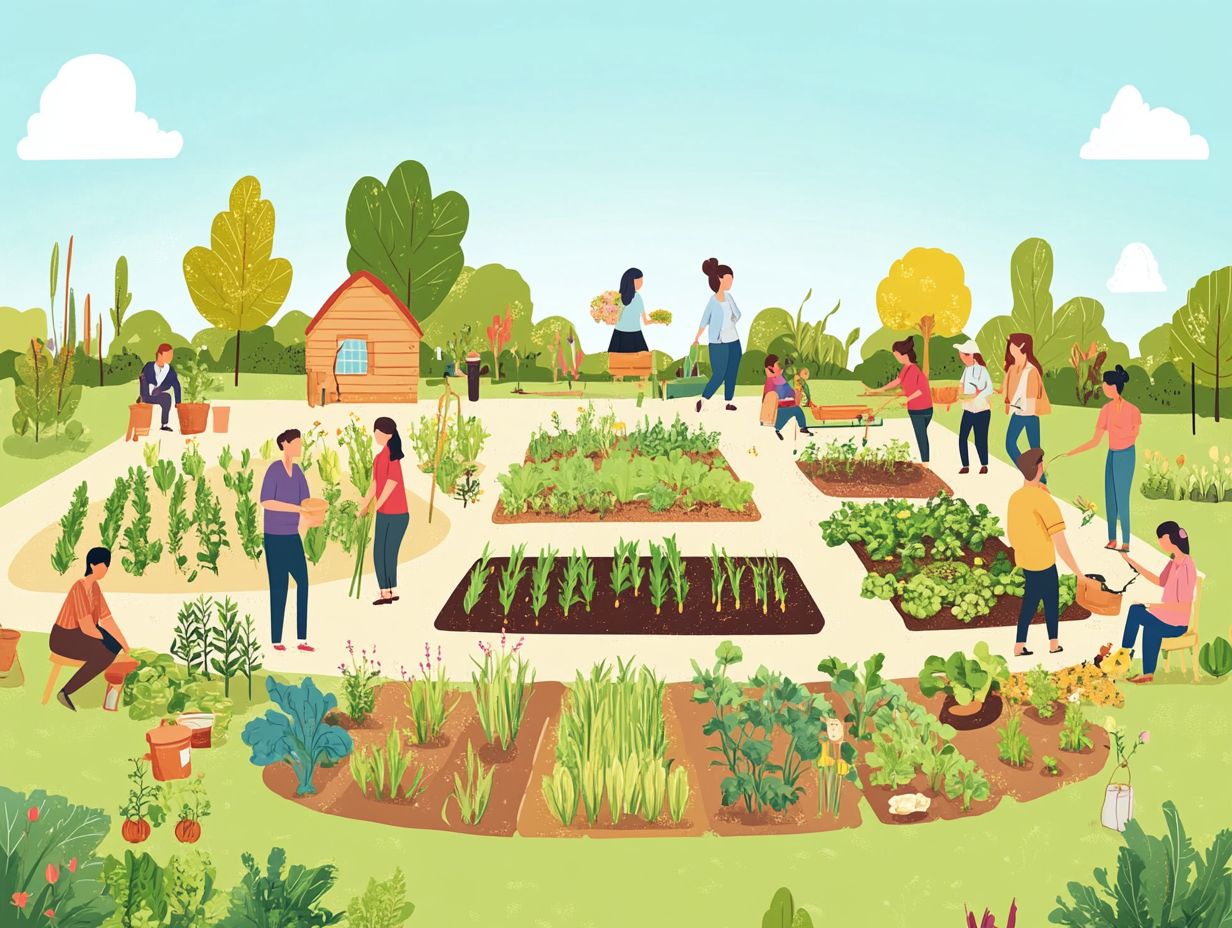
Permaculture encourages community collaboration and self-reliance, focusing on designing for climate resilience to create strong and resilient communities that adapt to changing conditions and challenges.
What are some key principles of permaculture?
Some key principles of permaculture include working with nature, using renewable resources, reducing waste, and promoting diversity.
How can permaculture help mitigate the effects of climate change?
Permaculture techniques such as water harvesting, natural building, and regenerative agriculture build resilience against extreme weather events and reduce carbon emissions, as highlighted in 79. 5 amazing case studies of urban permaculture.
What role do community gardens play in building community resilience through permaculture?
Community gardens serve as gathering spaces for neighbors, provide access to fresh and healthy food, and educate community members on permaculture techniques and principles.
How can individuals get involved in building community resilience through permaculture?
Individuals can join local permaculture groups, attend workshops and events, and implement permaculture principles in their homes and communities.

